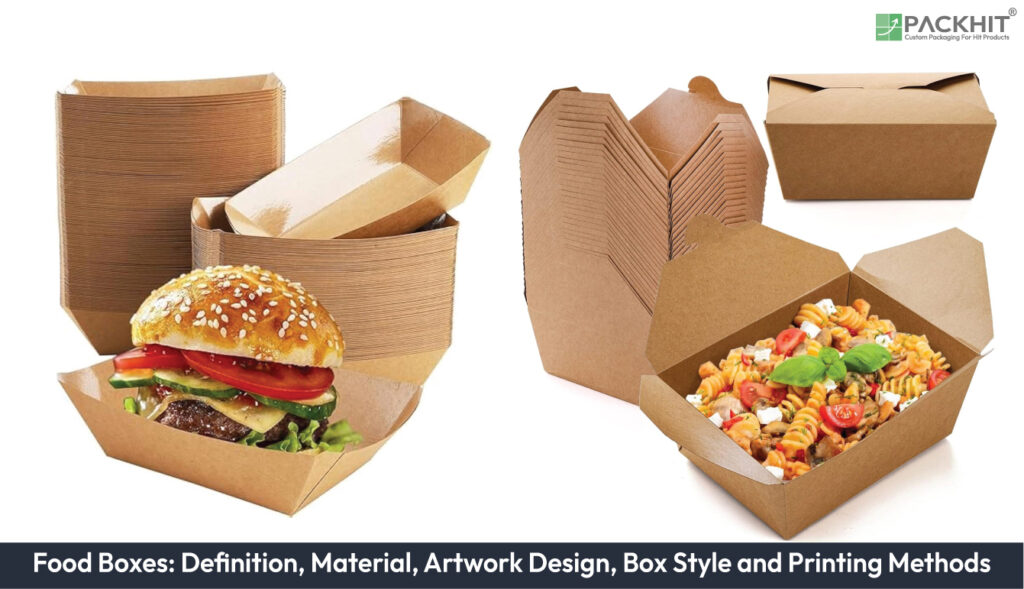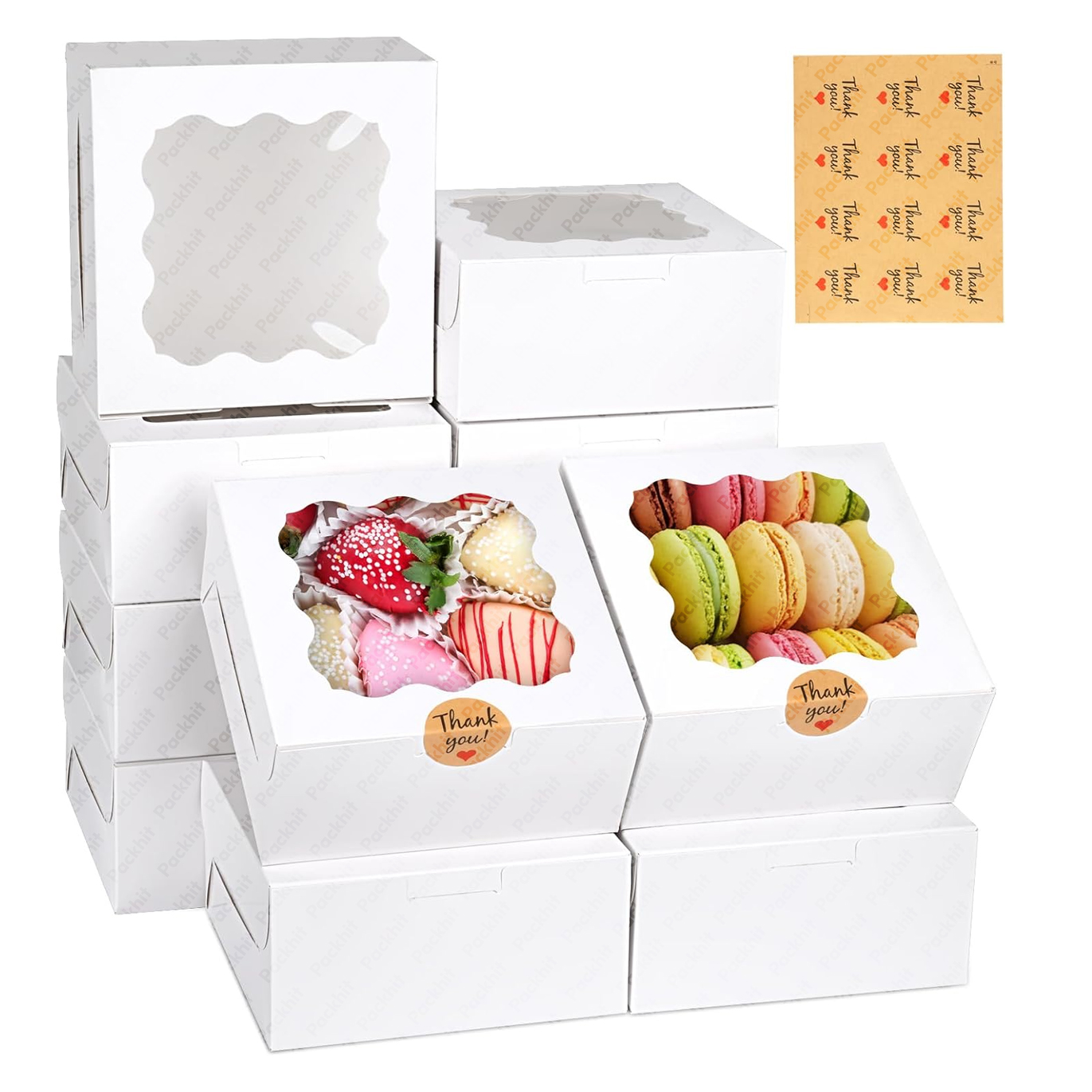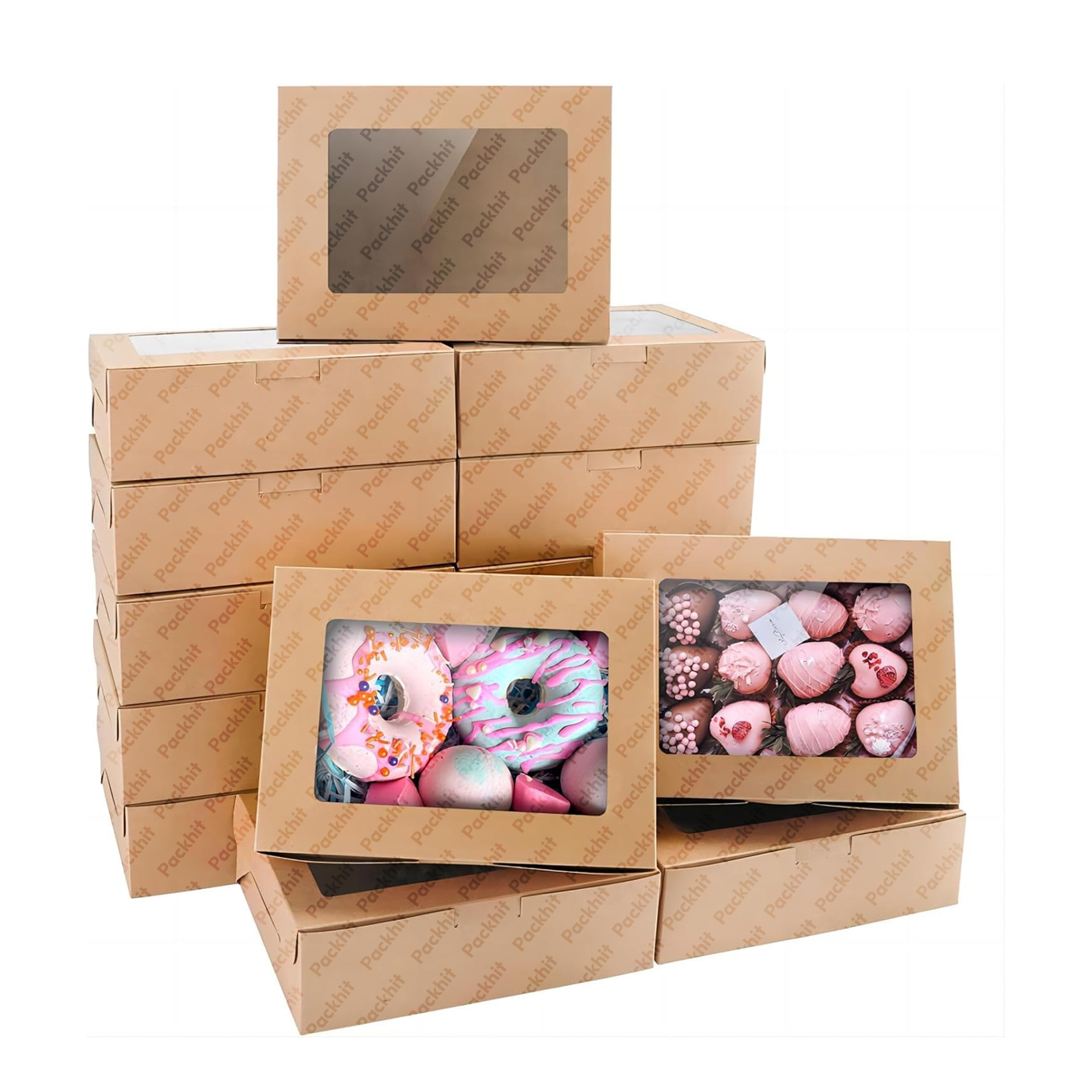Food boxes are versatile packaging solutions designed to store, protect, and present food items while maintaining their freshness and quality. Made from eco-friendly materials such as cardboard, kraft, and corrugated paperboard, these boxes are customizable in various styles, including gable, Chinese food boxes, window, and two-piece designs. With innovative printing methods like digital printing, flexography, and embossing, food boxes can be tailored to feature unique brand elements such as logos, color schemes, and creative artwork. Their sturdy construction ensures durability, protecting food during storage and transit, while additional features like airtight seals, greaseproof coatings, and inserts enhance functionality. Recyclable options contribute to environmental sustainability, aligning with global eco-conscious practices. These lightweight, stackable boxes simplify transportation, reduce costs, and elevate brand visibility through personalized designs and eco-friendly materials, making them an essential tool for businesses to enhance customer engagement and optimize operational efficiency.
- What are Food Boxes?
- How can Custom Food Boxes promote the brand?
- What materials are Food Boxes made of?
- What styles do Food Boxes come in?
- What printing and finishing methods can be used for Food Boxes?
- How do sturdy Food Boxes enhance durability?
- How can food products be stored in Food Boxes with added protection?
- How can recyclable Food Boxes contribute to sustainability?
- How can Food Boxes simplify transportation and delivery?
- How can businesses save money with affordable Food Boxes?
What are Food Boxes?
Food boxes are packaging containers made from cardboard material that are used to store, present, and deliver food items safely while maintaining their freshness and quality. Custom food boxes are made from durable and eco-friendly materials like cardboard and kraft, and come in many innovative styles such as gable, Chinese food box, window, two-piece, and mailer. These custom-printed food boxes are designed using different printing approaches like spot UV, stamp foiling, embossing, and debossing. Food boxes can be tailored with various designs, styles, and materials to align seamlessly with brand identity. These food packaging boxes incorporate customizable features such as unique shapes, creative artwork, and eco-friendly materials, ensuring they effectively promote a brand’s image while meeting functional requirements.
How can Custom Food Boxes promote the brand?
Custom food boxes significantly enhance brand visibility and customer engagement by incorporating tailored designs, high-quality materials, and advanced printing techniques. These boxes act as a medium to communicate a brand’s identity through visual and tactile elements. Key branding features include logos, unique color schemes, typography, and custom graphics that resonate with the target audience. Custom food packaging also allows businesses to align their aesthetic with their core values, such as sustainability, by choosing eco-friendly materials like kraft or recyclable cardboard. To elevate visual appeal, finishes like spot UV, embossing, and stamp foiling provide a premium look, while personalized features like die-cut windows or custom inserts enhance functionality and design. By effectively combining aesthetics with practicality, custom food boxes not only protect and present food items but also position the brand as a professional and memorable entity in the competitive market.
What materials are Food Boxes made of?
Food boxes are made from different sustainable materials like cardboard, kraft, paperboard, card stock, and corrugated. Cardboard material is a preferred choice for storing and shipping food items safely because it is lightweight, eco-friendly, and affordable. The cover paper materials for food boxes, like solid color, custom printed, foil, laminated, embossed, matte, and gloss papers, are used to enhance your food packaging. Food boxes can be customized with a variety of materials to align with brand preferences, including eco-friendly options. These selections ensure the packaging not only meets functional requirements but also reflects the brand’s identity effectively.
What styles do Food Boxes come in?
Food boxes come in a range of innovative styles listed below:
- Gable
- Chinese food box
- Window
- Two-piece
- Auto-Bottom
- Display
- Drawer
- Folding
- Four corner cake box
- Tray and sleeve
- Pillow
- Mailer
- Gable bag auto bottom
What printing and finishing methods can be used for Food Boxes?
Printing methods for food boxes are listed below:
- Digital printing
- Flexographic printing
- Lithography
- Screen printing
- UV varnishing
- Foil printing
- Inkjet printing
- Rotogravure
- Embossing
- Debossing
- Offset lithography
- Stamp foiling
- Laser printing
- Letterpress printing
- 3D Printing
How do sturdy Food Boxes enhance durability?
Sturdy food boxes enhance durability by being crafted from high-quality materials such as cardboard, which offers superior strength and longevity. These boxes maintain their structural integrity under pressure, ensuring food items remain safe during storage and transit. The high folding strength of these materials makes the boxes resistant to wear and tear, allowing them to withstand the rigors of handling and shipping. Opting for durable food boxes ensures that food products are protected, preserving their quality and presentation from production to delivery.
How can food products be stored in Food Boxes with added protection?
Food products can be stored with enhanced protection by using custom-designed food boxes equipped with airtight seals to guard against moisture, dust, and environmental changes. These boxes often include heat-retention foiling to maintain the warmth and freshness of food during storage and transit. Greaseproof coatings ensure that the food packaging is resistant to leakage and safe for microwave use, allowing for reheating as needed. To further improve functionality, food boxes can be customized with inserts to securely organize and protect food items from pressure during handling and delivery. These features collectively ensure the safety and quality of food products while enhancing their presentation.
How can recyclable Food Boxes contribute to sustainability?
Recyclable food boxes contribute to sustainability by utilizing materials such as cardboard, kraft paper, and cardstock, which are biodegradable and environmentally friendly. These materials not only reduce waste but also support a circular economy by being repurposed into new packaging or other paper products. The production of recyclable food boxes often involves less energy and fewer greenhouse gas emissions compared to non-recyclable alternatives, further minimizing their environmental impact. By adopting recyclable food boxes, brands demonstrate a commitment to eco-conscious practices, which can resonate with environmentally aware consumers. Features like water-based inks and minimal-use adhesives enhance the recyclability of these boxes, ensuring that they can be processed efficiently in recycling facilities. Incorporating clear recycling symbols and instructions on the packaging also encourages end-users to dispose of these boxes responsibly. Businesses that opt for recyclable food packaging can align their operations with global sustainability goals, such as reducing plastic pollution and conserving natural resources. By choosing these eco-friendly solutions, companies not only protect the environment but also strengthen their brand image as responsible and forward-thinking entities.
How can Food Boxes simplify transportation and delivery?
Food boxes simplify transportation and delivery through their lightweight yet durable cardboard construction, which ensures ease in handling and minimizes shipping costs. Their stackable design optimizes storage space, while secure closures prevent spills or damage during transit. Custom-designed food boxes, such as noodle packaging boxes, cater to specific food items, ensuring safe and efficient delivery. For added convenience, tracking options allow businesses to monitor the status of their shipments, ensuring timely deliveries across the United States.
How can businesses save money with affordable Food Boxes?
Businesses can save money on food packaging by opting for affordable yet high-quality food boxes. Ordering in bulk, with minimum quantities starting at 100 and scaling up to 100,000, allows companies to benefit from wholesale pricing. These cost-effective solutions ensure that quality is not compromised while meeting functional and branding requirements. By choosing economical food packaging options, businesses can allocate resources efficiently, maximizing profitability while maintaining the integrity of their food products.




